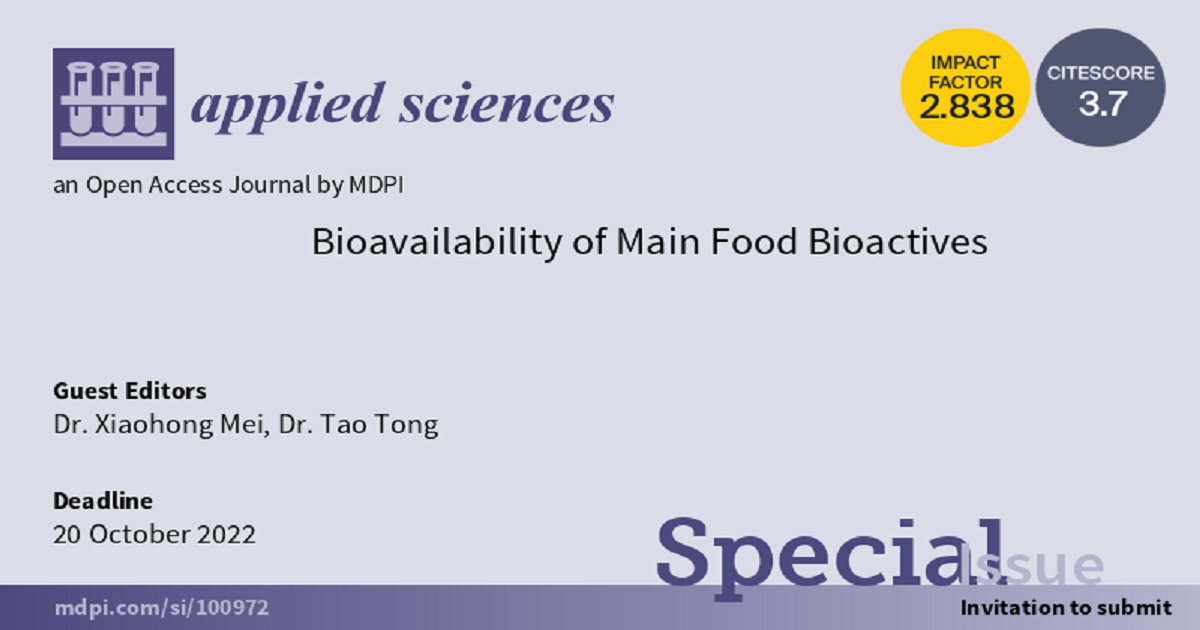Bioavailability of Main Food Bioactives
A special issue of Applied Sciences (ISSN 2076-3417). This special issue belongs to the section "Food Science and Technology".
Deadline for manuscript submissions: closed (20 October 2022) | Viewed by 2743

Special Issue Editors
Interests: isolation and identification of bioactive natural compounds; construction of food-grade delivery systems; functional properties of natural bioactives
Interests: functional foods; phytochemicals; chronic disease; skeletal muscle atrophy; photoaging; gut health
Special Issues, Collections and Topics in MDPI journals
Special Issue Information
Dear Colleagues,
The study of the bioavailability of food bioactives is a key step in the design of functional foods. The concept of bioavailability is generally defined as the fraction which is released from the food matrix in the gastrointestinal fluid and becomes available for absorption. However, the bioavailability of many bioactive components is limited due to their poor stability, low solubility in intestinal fluids and poor absorption through the intestinal cell monolayer. In recent years, many researchers have been dedicated to demonstrating the processes and mechanisms involved in the bioavailability of the bioactive substances and improving bioavailability by incorporating bioactive agents into various delivery systems. These are the reasons that this Special Issue, “bioavailability of main food bioactives”, has been created.
This Special Issue aims to collect excellent original and review works, focusing on the construction of food-grade delivery systems to enhance the bioavailability of bioactives; assessment methods for bioavailability of bioactives (particularly encapsulated bioactives); possible mechanisms involved in the digestion, absorption, and metabolism of bioactives (particularly encapsulated bioactives), etc.
Dr. Xiaohong Mei
Dr. Tao Tong
Guest Editors
Manuscript Submission Information
Manuscripts should be submitted online at www.mdpi.com by registering and logging in to this website. Once you are registered, click here to go to the submission form. Manuscripts can be submitted until the deadline. All submissions that pass pre-check are peer-reviewed. Accepted papers will be published continuously in the journal (as soon as accepted) and will be listed together on the special issue website. Research articles, review articles as well as short communications are invited. For planned papers, a title and short abstract (about 100 words) can be sent to the Editorial Office for announcement on this website.
Submitted manuscripts should not have been published previously, nor be under consideration for publication elsewhere (except conference proceedings papers). All manuscripts are thoroughly refereed through a single-blind peer-review process. A guide for authors and other relevant information for submission of manuscripts is available on the Instructions for Authors page. Applied Sciences is an international peer-reviewed open access semimonthly journal published by MDPI.
Please visit the Instructions for Authors page before submitting a manuscript. The Article Processing Charge (APC) for publication in this open access journal is 2400 CHF (Swiss Francs). Submitted papers should be well formatted and use good English. Authors may use MDPI's English editing service prior to publication or during author revisions.
Keywords
- bioavailability
- bioactive compounds
- delivery systems
- assessment methods.






